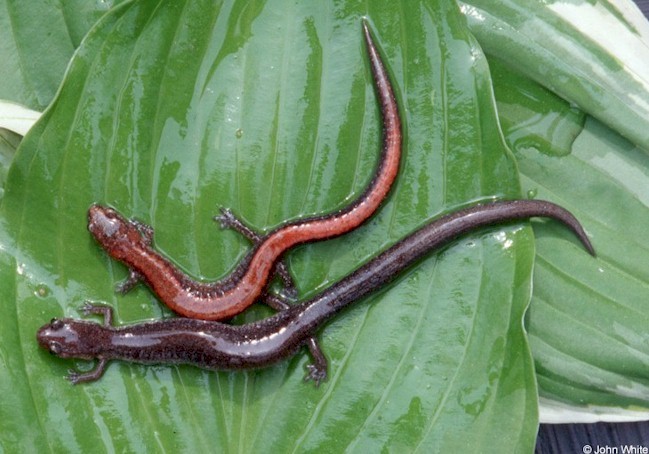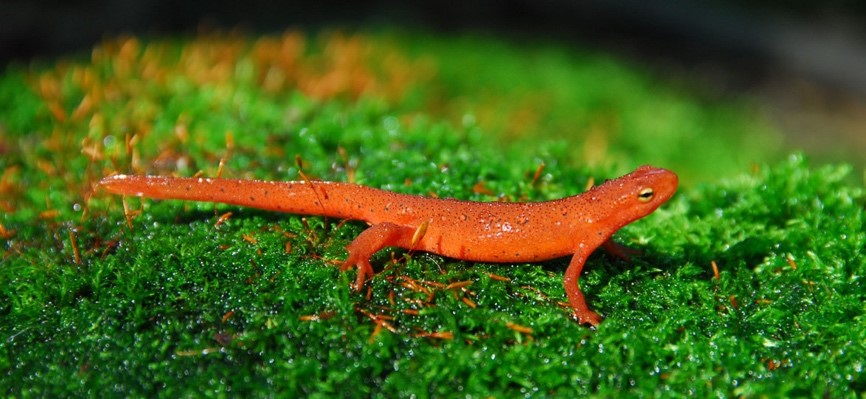Right- Eastern Newt from Vermont Fish and Wildlife
By Chloe Sardonis
Forests are crucial to maintaining water quality, air quality, storing carbon, providing habitat, and providing us with a valuable resource: wood. There are ways to manage forests in such a way that we meet the needs of the landowner while focusing on new growth and the establishment of future forests. When forests are managed sustainably, a landowner can produce wood (yes, which means cutting trees) while also supplying the world with the services listed above. Forest management is more and more geared towards healthy forests, and healthy forests are being realized as a tool to fight climate change. However, while managing forests for the benefits of the forest and the health of the trees is great, we also need to think about the impacts of our forest management on the species that depend on them. Dr. Marlyse Duguid, director of the Yale Research Forest, has set out to answer the question “How does forest management affect non-target organisms?” Every organism has its own habitat needs and requirements, and while some requirements overlap, some are completely different.
Let’s look at the Eastern Red-backed Salamander and the Eastern Newt. Two salamander species that at first glance might seem like they are pretty similar. As a juvenile, the Eastern Newt (called a red eft during this life stage) and the Red-backed Salamander both live in our northeast forests. They are around the same size and they have a similar diet of invertebrates. If we were to cut trees in a way that is great for the forest, will it be great for salamanders? Do all salamanders respond to forest management the same way?
Yale Research Forest has been managed in a way that allow for these questions to be answered. The unique study site they have there is called a chronosequence. This is a set of sites within the forest that are ecologically similar but are all at different stages of the same type of management. This means they have one site that has just been cut in a specific way, one site that has not been cut at all, and sites in between that range from a year since the cutting to 25 years since the cutting. Essentially this allows Dr. Duguid and other researchers to look at the forest’s response to these cuttings over the course of time, except they can see it all at once!
I spoke to Dr. Marlyse Duguid, a forester, botanist, horticulturist, and ecologist, as well as being the Director of Research at the Yale Research Forest. She explained a chronosequence is not a perfect system, but it uses time as a proxy and allows for researchers to measure habitat for any forest species including birds, understory plant communities, and amphibians. Last summer, Dr. Duguid published a paper with Angus Mossman, Max Lambert, Mark Ashton, and Jessica Wikle that used the research forest to study the effects of a timber harvest on our two salamander species from above, the Eastern Newt and Red-backed Salamander. Using the Yale Research Forest, they were able to count the numbers of each species at each one of the sites, starting with immediately after the harvest and working up to 25 years after. They could then compare those numbers with the site that had never been cut.
The results were clear, not only does forest management have an effect on amphibians, it effects these amphibians on a species level. Both types of salamanders had their lowest numbers immediately after the timber harvest, although the Red-backed Salamander’s populations had recovered to even higher numbers 25 years after the timber harvest than they were in the uncut area. The Eastern Newt, though, fared differently and even 25 years after harvest, they still didn’t have the population numbers that they had in the uncut site.
If these differences can occur between organisms that are relatively alike, I was curious how a forester can think about management and consider everything at once, like the trees, the forest as a whole, all the different types of animals, etc.? With this background, Marlyse was the perfect person to ask how one measures what is “good” for the forest, or even what we are referring to when we speak on the “good of the forest?”
“If you were just managing for carbon, you might just grow eucalyptus everywhere. You want a diverse portfolio of values.” Marlyse explained.
“You can’t serve every value.” Marlyse continued. She went on to say it was okay to stack values. There are so many different services provided by forests, that you have to choose what your values are when managing and be sure to not manage everything the same way.
As we saw in the research on salamanders, what is good for one species is going to be hard for another. Humans have to make these decisions and this research helps to inform management. For this reason, Dr. Duguid chose to publish this paper open access. It was more expensive, but she believed, because this paper is management-based, it should be accessible to everyone.
This study demonstrated that forest management affects the organisms living within the forest in different ways. Dr. Duguid emphasized that this study only looked at one small window of time and, even still, the results were clear. More research could be done for this and other amphibian-related forest-use studies.
With many challenges present for both the woods and the organisms in the woods, such as climate change, invasive species, pests, etc., forest management will need to be aware of the gives and takes of operations to continue providing the services we desperately need. While doing that, we can’t forget about the tiny creatures beneath the dead leaves and logs on the forest floor. Yale Research Forest and the work of Dr. Duguid can help us to understand our impacts in the forest beyond the trees.
The article, titled “Two salamander species respond differently to timber harvests in a managed New England forest” can be found at https://peerj.com/articles/7604.pdf.
Photo credits:
Top Left- Eastern Red-backed Salamanders from Virginia Herpetological Society
Top Right- Eastern Newt from Vermont Fish and Wildlife


